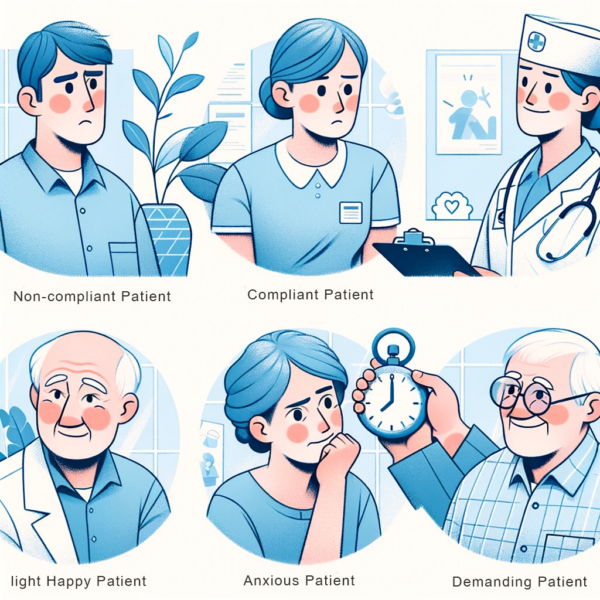
If you work in healthcare, it means stepping into the world of handling different types of patients in hospitals, each presenting unique challenges. No two patients are the same, each demanding a specific approach. With that in mind, let’s discover some essential strategies to effectively deal with five most common patient types in medical settings, including understanding the patient type’s meaning in various contexts.
Benefits of Understanding Patient Types
By understanding patient types, healthcare providers can:
- Build rapport and trust with patients
- Improve patient satisfaction
- Enhance patient compliance with treatment plans
- Reduce the risk of medical errors
- Improve overall patient outcomes
The Compliant Patient
Compliant patients are considered the ideal. They follow their medication regimen just right, observe all appointments, and meticulously adhere to lifestyle changes suggested by their healthcare providers. While these patients seemingly make life easier, they also need specific attention.
One thing to remember is to acknowledge their efforts. Positive reinforcement can go a long way toward maintaining this type of behavior. Also, assure them they can voice their concerns if they have any. An open line of communication is pivotal in addressing any possible issues or misunderstandings.
Lastly, provide them with comprehensive explanations about their treatment plan. Remember, they want to fully participate in their healthcare management, and understanding what’s going is essential.
The Non-compliant Patient
On the flip side, we have non-compliant patients. This group can present a real challenge. They miss appointments, don’t adhere to their treatment plan, and often ignore medical advice. Moreover, their non-compliant behavior can sometimes lead to complications in their conditions.
However, with patience and understanding, these hurdles can be overcome. Start by explaining the consequences of non-compliance clearly and firmly. Lay out the potential risks and complications they might face if they don’t follow the treatment plan.
Moreover, it’s essential to establish a trusting relationship. Show them you’re on their side and you’re working together for their well-being. It also helps to determine the cause of their non-compliance; maybe a fear or misconception needs to be addressed.
The Anxious Patient
We’ve all felt anxiety at some point, especially regarding health problems. However, some patients experience it more severely, becoming nervous, restless, and even scared. Dealing with them demands lots of patience and reassurance.
Firstly, you need to validate their fears and show empathy. Remember, their fear is real, and dismissing it will only increase their anxiety level. Reassure them about the procedure, explaining it in simple, clear terms, maybe even demonstrating it if possible.
Secondly, encourage them to talk about their feelings. Sometimes, just voicing their concerns can alleviate a lot of their anxiety. Finally, remain calm yourself. Your calm demeanor can influence them, helping them to relax in the process.
The Demanding Patient
Demanding patients can be tough. They want answers now and solutions quicker. They’re often the ones who ask endless questions, demand more tests, and want immediate improvements. Managing them requires strong communication and interpersonal skills.
Set realistic expectations right from the start. Explain the treatment plan, timeline, and what they can expect. Don’t promise quick fixes if they’re not possible. It’s also crucial to maintain patience and a professional demeanor with them.
Remember, it’s never personal. Most of the time, they’re just fearful or insecure about their health, so being compassionate can help manage their demands and keep you sane!
The Demanding and Occasionally Angry Patient
Demanding patients, including the occasionally angry ones, can be challenging. They want immediate answers and quicker solutions. They often inundate you with endless questions, demand more tests, expect instant improvements, and show their anger when their expectations are unmet.
Managing such patients requires strong communication skills and patience. Whether their demands stem from fear, anxiety, or anger, it’s important to tread carefully. Start by setting realistic expectations, explaining the treatment process and timeline, and ensuring they understand that quick fixes might not be possible.
With angry patients, listen to their complaints without interrupting and acknowledge their feelings. Always speak respectfully and calmly, helping diffuse the situation. Your demeanor can profoundly impact the way they respond. The key is to remain patient in the face of their anger, taking it in stride and understanding that it is often a natural response to fear or frustration.
Never take their outbursts personally. Most of the time, they’re just fearful, insecure, or frustrated about their health or the treatment process, so showing compassion can help manage their demands and anger, keeping your professional relationship intact.
The Call-light Happy Patient
Then there are the ‘call-light happy’ ones. They ring the nurse’s call bell for everything and anything. Sure, it can be frustrating. Nevertheless, understanding their condition and utilizing some practical strategies can make things easier.
Firstly, assess the reasoning behind their frequent calls. Are they bored? Or in distress? Often, they need assurance of your ongoing attention and care.
Regular check-ins could be a good solution and keep them from constantly reaching for the call light. Also, ensuring they have everything they need, including some leisure activities, can help reduce call light usage.
Types of Patients in ICU
Patient types can vary significantly in the ICU. Due to the severity of their conditions, these patients often require more intensive care and monitoring. Understanding ICU patients’ unique needs and challenges is crucial for effective care.
Importance of Communication
It’s undeniable that regardless of the type of patient, effective communication is one of the most crucial aspects of healthcare. Clearly defining treatment expectations and explaining medical matters in a language they understand can prevent miscommunication and promote adherence to treatment plans.
This is where Effective Patient Education steps in. It’s more than just giving information; it’s about making sure patients understand their condition, the importance of the treatment plan, and their role in managing their health. Remember, the goal is to empower them to make informed decisions about their healthcare.
Methods like using simple language, visual aids, written instructions, or even demonstrating procedures can make a considerable difference. Be sure to ascertain their understanding by asking them to repeat information back to you or ask any questions they may have.
The Role of Personalization
Every patient is different, and personalizing care is key to a successful provider-patient relationship. Knowing a patient’s personality type and tailoring your communication style and approach to their unique needs will create a positive impact.
From compliance-focused patients to anxious ones, a personalized approach can make all the difference in patient satisfaction.
Maintaining Professional Boundaries
Lastly, while it’s crucial to empathize and understand patients, maintaining professional boundaries is equally important. Remember, you’re their healthcare provider, not their confidante.
Balancing compassion with professionalism protects you and your patients, ensuring the best quality of care.
Tailoring Communication and Care
The most effective way to to deal with different types of patients is to tailor one’s approach to their individual needs. This means:
- Using language that is easy for the patient to understand
- Avoiding medical jargon
- Being respectful of the patient’s cultural background and beliefs
- Involving the patient in decision-making
- Providing clear and concise information about the patient’s condition and treatment plan
- Answering the patient’s questions in a patient and understanding manner
- Addressing the patient’s concerns
- Showing empathy and compassion
Expert opinions
A patient-doctor relationship thrives on open communication and trust, fostering a path towards better health. Let’s explore this concept further with a quote from a medical expert. William Osler canadian physician said, “Let the young know they will never find a more interesting, more instructive book than the patient himself.” This highlights the importance of understanding the patient’s perspective. Additionally, Francis Peabody emphasizes the key qualities of a good doctor, stating “The best of physicians are those who are good observers, careful thinkers, and skilled in the art of communication.”
Conclusion
Healthcare isn’t a one-size-fits-all kind of job. Dealing with different personalities may be demanding, indeed. However, these challenges can be successfully navigated with understanding, empathy, effective communication, and the right strategies. This provides an invaluable part of healthcare provision – creating a positive patient experience on their recovery journey.










